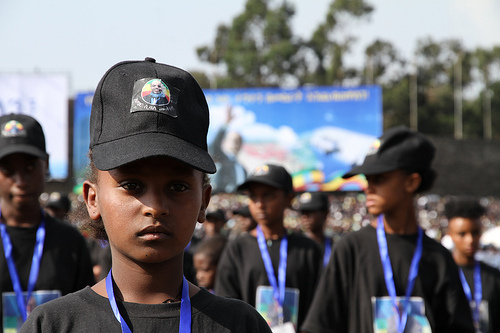Sympathizing with Art that Lacks Sympathy
by Mesfin Negash / September 21, 2012 / 1 Comment
How much responsibility does an artist have in a dictatorship?

Photo from visit by Heikki Holmås of the Norwegian Ministry of Foreign Affairs to Ethiopia. Photo taken on September 2, 2012. Photo: Trond Viken
The recent death and mourning of the late dictator in Ethiopia has prompted a number of interesting questions. One asks about the artist’s (writer, musician, playwright, etc.) place in the relationship between a despot and his subjects. Where do an artist’s personal and public choices and responsibilities start and end? Should the audience see the artist and his work as separate entities? When an artist mourns and eulogizes the death of a brutal dictator is he denying the suffering that this despotic hero inflicted upon the audience? How can an artist ignore the death and suffering of millions yet mourn the death of a cruel dictator? What is humanity to such an artist? Should the audience forget the artist while appreciating their work? If so, where is “artistic integrity” located—in the work, the person, or both?

- Why does a country with her own unique alphabet and long history of writing persist to deny citizens the right to freedom of expression in this era of Expression? No other country in Africa may typify this paradox more than Ethiopia. As Leopold Senghor’s famous collection of poems entitled “Ethiopiques” remained ‘powerful and popula’ so does the source of his intriguing title, Ethiopia, in her own ways. In “Ethiopiques,” I share Ethiopian views on pertinent issues related to journalism, culture and, of course, the overarching subject of politics.

- Mesfin Negash is an Ethiopian journalist living in exile in Sweden. He is one of the journalists accused of “terrorism” in 2011 by the Ethiopian government. The co-founder and first editor-in-chief of an acclaimed Ethiopian newspaper, Addis Neger, he is currently the Managing Editor of Addisnegeronline.com. He is a political science student by training and known for his critical commentaries on significant political and social issues.
Both ruler and subject claim that the artist is there to serve their respective causes, though at his best the artist is expected to be independent of both. Artistic integrity is ultimately a function of these factors in addition to the artist’s creative excellence. This may take us to a philosophical debate on the nature and goals of art itself, but whatever an artist’s position may be, their works cannot be neutral objects in human history. There is no neutrality when it comes to freedom and oppression.
The question becomes starker when placed under the shadow of a dictatorship. Most artists in this situation avoid the dilemma by staying away from the subjects of freedom and justice. This strategy is typical for a majority of Ethiopian artists who have been effectively employed for decades. They try to appear indifferent to the plight of the public in their work, or find subtle and hazy ways to communicate their message. One might argue that avoiding the subject is a statement of its own in support of, or opposition to, the repression. The most popular themes in this approach are love of the nation and compatriotism. These themes, in most cases, are intentionally framed to conceal the fact that the work’s audience is suffering from an absence of freedom and justice. Very few dare to express the suffering and yearning of the voiceless in their work, or on other platforms. Those who do express the deep and genuine concerns of the public do so mostly in times of famine and external aggression.
I respect artists’ personal choices and methods of survival under dictatorship. Many consider their silence a creative coping mechanism, assuming that it is better for an artist to produce “freedom-free” works than end up in prison or exile.
Artists from all walks and times represent some aspect of the society they live in. Spectators usually confuse this personal reality with their image of an ideal, universal Artist who stands for “good” and humanity. In this light, one shouldn’t be disappointed by an artist who compromises their “artistic integrity.” Instead one should fine-tune one’s expectations of real artists. The artist does not have a responsibility to my freedom or to voice the dreams and suffering of millions. However, those exceptional artists who stand by the oppressed are gifts to humanity. After all, art is ideal. Artists, on the other hand, are another matter.





One Comment on "Sympathizing with Art that Lacks Sympathy"
Trackbacks for this post